Preface
As teachers, we know that undergraduate science education is evolving. Simply conveying facts does not produce a scientifically literate student, a long-
Textbooks are an important part of the equation. A good textbook must now be more than a guide to the information that defines a discipline. For instructors, a textbook must organize information, incorporate assessment tools, and provide resources to help bring a discipline to life. For students, a textbook must relate science to everyday experience, highlight the key concepts, and show each student the process that generated those key concepts.
This book had its genesis at a meeting of the authors in Napa Valley in January 2006. From the outset, we set ambitious goals designed to address the key challenges we face as teachers.
Students see science as a set of facts rather than an active human endeavor.
Molecular biology has a wealth of important stories to tell. We wanted to convey the excitement that drives modern molecular biology, the creativity at the bench, and the genuine wonder that takes hold as the workings of a new biological process are revealed. This theme is set in the first chapter, dedicated in large measure to an introduction to the scientific process. Every chapter then begins with a Moment of Discovery, highlighting a researcher’s own description of a memorable moment in his or her career. After Chapter 1, every chapter ends with a How We Know section, with stories relating the often circuitous path to a new insight. Additional anecdotes—
This second edition is an update, and much more. It has allowed us to refine the initial vision we had when we started this project and to augment that vision with unparalleled resources that will bring the subject to life for students and educators alike.
MOMENT OF DISCOVERY
Scientific breakthroughs represent the exhilarating culmination of a lot of hard work. Each chapter opens with a description of a significant breakthrough in molecular biology, told by the scientist who made the discovery. The scientists featured in the Moments of Discovery are David Allis, Norm Arnheim, Bonnie Bassler, Steve Benner, James Berger, Carlos Bustamante, Rose Byrne, Jamie Cate, Joe DeRisi, Roxana Georgescu, Lin He, Tracy Johnson, Melissa Jurica, Judith Kimble, Robert Lehman, Steve Mayo, Harry Noller, Smita Patel, Lorraine Symington, Jack Szostak, Robert Tjian, and Wei Yang.
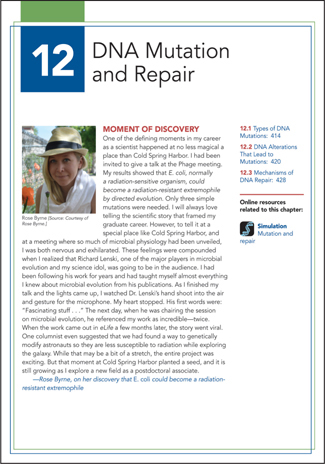
xxi
HOW WE KNOW
Each chapter ends with a How We Know section that combines fascinating stories of research and researchers with experimental data for students to analyze.
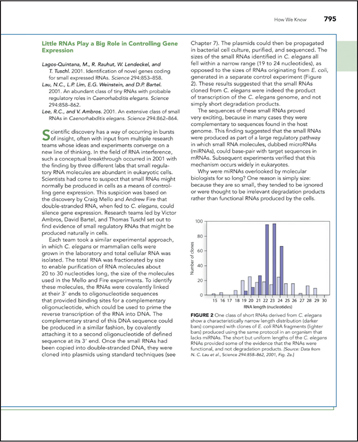
Students often view science as a completed story.
The reality is far different. Data can take a researcher in unexpected directions. An experiment designed to test one hypothesis can end up revealing something quite different. The analysis of real data is a fundamental skill to be honed by every student of science. We have tried to address this need aggressively. Each chapter in this text features a challenging set of problems, including at least one requiring the analysis of data from the scientific literature. Many of these are linked to the discoveries described in the How We Know sections. Each chapter also ends with some Unanswered Questions, providing just a sampling of the endless challenges that remain for those with the motivation to tackle them.
UNANSWERED QUESTIONS
A short section at the end of each chapter describes important areas still open to discovery, showing students that even well-
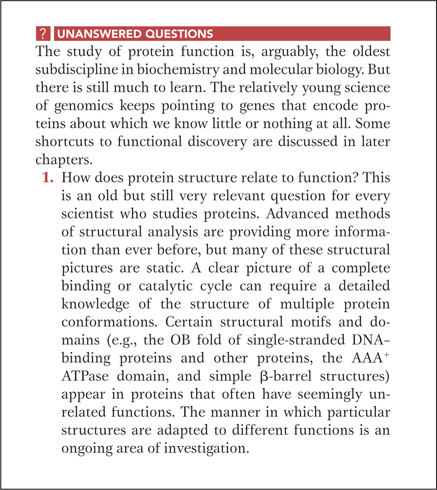
END-OF-CHAPTER PROBLEMS
Extensive problem sets at the end of each chapter give students the opportunity to think about and work with the chapter’s key ideas. New problems have been added in each chapter for this second edition. Each problem set concludes with a Data Analysis Problem, giving students the critical experience of interpreting real research data. Solutions to all problems can be found at the back of the book.
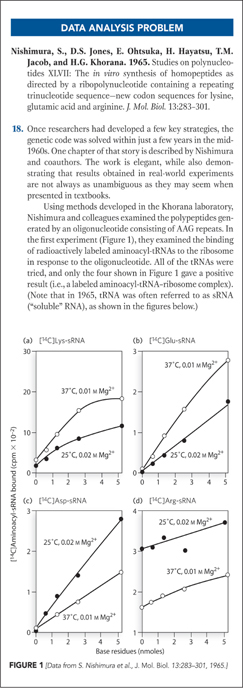
xxii
Students get lost in the details.
Presenting the major concepts clearly, in the text as well as in the illustrations, is crucial to teaching students how science is done. We have worked to use straightforward language and a conversational writing style to draw students in to the material. We have collaborated closely with our illustrator, Adam Steinberg, to create clean, focused figures. Featured Key Conventions highlight the implicit but often unstated conventions used when sequences and structures are displayed and in naming biological molecules.
KEY CONVENTIONS
In brief paragraphs, the Key Conventions clearly lay out for students some fundamental principles often glossed over.

ILLUSTRATIONS
Good figures should speak for themselves. We have worked to keep our figures simple and the figure legends as brief as possible. The illustrations in the text are the product of close collaboration with our colleague Adam Steinberg. Together with the talented artists at Dragonfly Media Group, Adam has helped to hone and implement our vision.
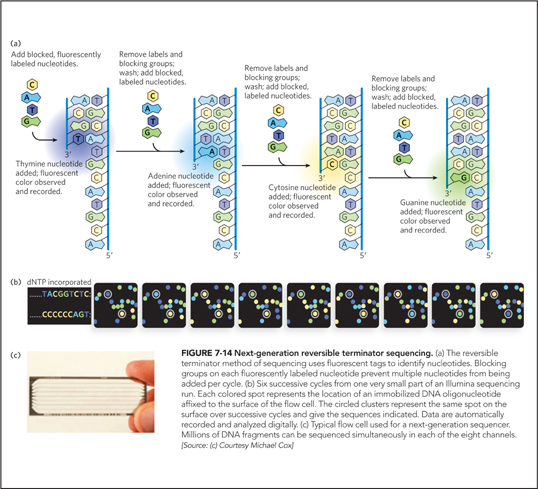
Students see evolution as an abstract theory.
Every time a molecular biologist studies a developmental pathway in nematodes, identifies key parts of an enzyme active site by determining what parts are conserved among species, or searches for the gene underlying a human genetic disease, he or she is relying on evolutionary theory. Evolution is a foundational concept, upon which every discipline in the biological sciences is built. In this text, evolution is a theme that pervades every chapter, beginning with a major section in Chapter 1 and continuing as the topic of many Highlights and chapter segments.
HIGHLIGHTS
These discussions are designed to enhance students’ understanding and appreciation of the relevance of each chapter’s material. There are four categories of Highlights:
Medicine explores diseases that arise from defects in biochemical pathways, and how concepts uncovered in molecular biology have contributed to drug therapies and other treatments.
Technology focuses on cutting-
edge molecular biology methods. Evolution reveals the role of molecular biology research in understanding key biological processes and the connections among organisms.
A Closer Look examines a wide variety of additional, intriguing topics.
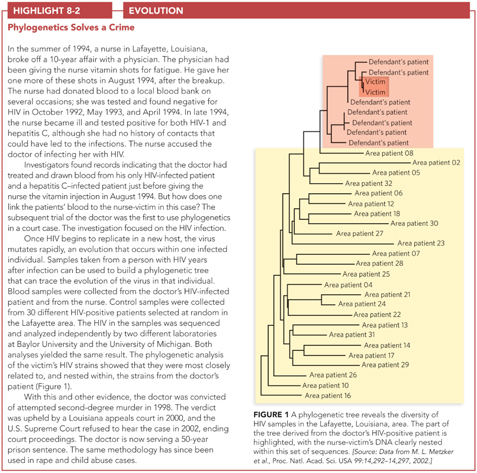
xxiii
EXPERIMENTAL TECHNIQUES
As researchers, we know that it is critical to understand the benefits and limitations of experimental techniques. We strive to give students a sense of how an experiment is designed and what makes the use of a particular technique or model organism appropriate. The techniques covered in this book are:
Ames test 424
Chemical modification interference 700
Chemical protection footprinting 700
Chemical synthesis of nucleic acids 201
ChIP-
ChIP-
Chromatography
Affinity chromatography 100
Using terminal tags 237
Using tandem affinity purification (TAP) tags 242
Column chromatography 100
Gel-
Ion-
Thin-
CRISPR/Cas 246
Detecting A=T-
DNA cloning 212
DNA cloning with artificial chromosomes (BACs, YACs) 218
DNA footprinting 700
DNA genotyping (DNA fingerprinting, DNA profiling, STR analysis) 224
DNA library creation (cDNA, genomic) 220
DNA microarrays 244
DNA sequencing
Automated Sanger sequencing 226
Deep sequencing 232
Genome sequencing techniques 260
Ion torrent 232
Next generation sequencing 229
Pyrosequencing 229
Reversible terminator sequencing 230
Sanger sequencing 226
Single molecule real time (SMRT) sequencing 230
Electrophoresis
Agarose gel electrophoresis 199
Isoelectric focusing 277
Pulsed field gel electrophoresis (PFGE) 220
Sodium dodecyl sulfate–
Two-
Electrophoretic mobility shift assay (EMSA) 700
Electroporation 217
Epitope tagging 240
Haplotype analysis 269
Immunoprecipitation 242
Linkage analysis 272
Localization of GFP fusion proteins 239
Mass spectrometry 278
Northern blotting 199
Nuclear magnetic resonance (NMR) 115
Optical trapping 344
Photolithography 244
Phylogenetic analysis 270
Phylogenetic profiling 279
Polymerase chain reaction (PCR) 222
Quantitative PCR (qPCR) 222
Reverse transcriptase PCR (RT-
Protein chips 280
Protein localization via indirect immunofluorescence 240
Recombinant protein expression 232
RNA interference (RNAi) 774
RNA-
Selection and screening 217
Site-
Somatic cell nuclear transfer (SCNT) 538
Southern blotting 199
Transformation 217
Western blotting 241
X-
Yeast three-
Yeast two-